Discover This Drink: Is Mead The Next Cider?
By Melissa Wiley in Food on Jun 26, 2014 6:00PM

Wild Blossom Meadery & Winery Pirate's Blood Mead, which contains three different types of chili pepper (Image courtesy Wild Blossom's Facebook Page)
Mead doesn’t show its age. Perhaps that's because honey remains the one food that never spoils, assuming you believe 2,000-year-old jars exhumed from Egyptian tombs still taste succulent. Or maybe it’s just time for the nectar of the gods to start riding on cider’s resurgent coattails. Whatever the reason, mead is on the rise.
No one knows exactly when mead was invented, but it likely wasn’t long after some thirsty cave folk crawled out of their holes and guzzled some fermented rainwater dripping from a pendulous beehive and got tiddly in the process. Now you can buy a glass at the Hopleaf (5148 N. Clark St.) or a bottle of Wild Blossom Meadery’s local brew at any Binny’s, Whole Foods or Mariano’s in town. Ethiopian restaurants like Demera (4801 N. Broadway) have long stocked their share of honey wine, known as tej, as well.
There are about 250 meaderies in the US, but so far Illinois has just one. Greg Fischer’s Wild Blossom Meadery & Winery in Beverly is set to expand to an 8,000-square-foot building at 91st Street and Hermitage Avenue later this summer to meet burgeoning demand.
“Cider drinkers migrate to mead,” Fischer told Chicagoist. “Cider makers are now making cyser (fermented honey and apple cider) to add more complexity." And despite mead's sweet stereotype, not all mead is sweet. Fischer adds, "Mead tends to offer more complexity and varieties than cider, so it’s a natural progression. Generally our taste buds tend to like things sweet. But too much sweetness can be a turn-off. When the sweetness is balanced with big flavor and crisp acid, though, it can be irresistible.”
The craft beer revolution has also played its part, opening consumers to a wider array of options to pair with food, though with mead Fischer recommends Asian, Mexican and anything spicy that whets your umami sensors. Like the bees he tends, he is also a master alchemist, creating new varieties, blended with blueberries, cranberries or chocolate, every year, while his “sweet desire,” made in bourbon barrels, remains his signature.
Fischer, who previously worked as a commercial apiarist in New York, Washington and Florida, admits that when he first moved to Chicago it wasn’t exactly love at first sip.
“When I first tried to make mead, I didn’t like it and so didn’t think much about it. When I moved to Chicago, though, and met Ray Daniels, he turned me on to great mead. I noticed there was a need and that we had the resources right here in Chicago to make world-class mead.”
Mead mirrors the flavor of its honey. And true to his meadery’s name, much of Midwestern honey derives from wildflowers, which lend Illinois mead what Fischer calls “a good floral character with nice complexity and balance.”
“A good mead should have complexity of both floral and honey flavors. It leaves your palate clean and crisp and makes you clammier for another sip.”
In pagan times, brides and grooms quaffed mead for a month after their wedding to enhance fertility, the origin of the term “honeymoon.” The tipple of the Canterbury Tales’ urbane set, mead’s availability waned drastically in England when a divorcing King Henry VIII dissolved the monasteries, where beekeeping and mead making kept the monks from idle hands.
As beekeeping began recapturing the modern imagination, more mead on the commercial scene became a mere matter of time. But its comeback has been a gradual one for a reason. And it’s not just because it can strike some as too saccharine.
“Honey is much harder to produce than apples, grapes and grain,” Fischer reminded us. “Our production costs are much higher, for example, than that of breweries and wineries. That’s why cider, wine and beer became more popular. They were easier to make and cheaper to produce without getting stung by bees in the process.”
For Fischer and other mead makers around the country, beekeeping, however painstaking, presents the true attraction of transmuting honey into the world’s oldest alcoholic beverage. Bees also make for an exceptionally eco-friendly production process.
“The great thing about mead production is that it is super sustainable. To make one bottle of mead, bees have to pollinate over 2 million flowers, which produce to 20 to 40 million new seeds that make this planet greener. To produce honey, you also don’t need any pesticides, herbicides, fungicides, fertilizer, cultivation or irrigation. All you need is a clean, green environment. We also do not have to boil our produce, so mead requires the least energy of any alcoholic beverage.”
In its expanded facility, Wild Blossom Meadery will house its own bee sanctuary, hoping to make 70 to 80 percent of its mead from honey gathered in house and the rest from local beekeepers, including hives in nearby Dan Ryan Woods, the Morton Arboretum, and along the lakefront where the U.S. Steel South Works once stood. An asset in terms of clean energy, bees also carry the risk of devastation via disease and historically harsh winters.
“We got kicked in the butt by this year's deep freeze,” Fischer acknowledged, “with 60 to 70 percent of colonies not making it to spring. We brought in new bees and queens from the South, though, and they are bringing in loads of honey. If we don't get a big drought, we should do as well or better than last year.”
Discover This Drink is a new series highlighting drinks beyond your everyday cocktail, cider, beer, and wine options.